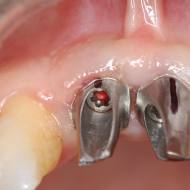IMPLANTOLOGY
Early loaded implants
The healing period for an implant normally varies from 3 to 6 months, and is still considered a fundamental prerequisite for obtaining the direct bone apposition on the titanium implant surface, without the interposition of fibrous scar tissue. Several authors have already demonstrated how early loaded implants (i.e. with a waiting time less than indicated above) do not necessarily give rise to the formation of connective tissue interposed between the implant surface and the bone, but this occurs only in consequence of excessive micromotion at the bone-implant level during the healing phase, leading to implant failure. Therefore in some selected cases it is possible to use the system after a shorter waiting time, especially thanks to the current objective systems for verifying the implant’s stability (use of the resonance frequency)
Post-extraction implant
Consists of the insertion of an implant immediately after extraction of the tooth and not after the traditional waiting time for healing; this is currently a widely studied and very predictable surgical technique. The post-extraction implants favour the maintenance of the soft tissue profile, the volumes of the bone crest are maintained (which is subject to resorption following dental extraction) and at the same time they reduce the overall duration of the treatment plan that is proposed to the patient. Several studies have shown that the success rate of this type of intervention is comparable to that of traditional implantology (with implant insertion in a healed bone site).
The advantages offered by this surgical technique are basically two:
1. avoid the second intervention to insert the implant in the healed bone site after extraction (at 2 – 4 months from extraction);
2. reduce the time between tooth extraction and the prosthetic intervention, thus decreasing the edentulous period and the total time allocated for treating the patient.
Immediate loaded dental implants
The implant is loaded immediately, with a special dental abutment, temporarily or permanently, depending on the case. In practice, the implant is inserted and instead of waiting the normal healing period, the tooth is positioned immediately. This is possible only when the missing element is not the last tooth, but is interposed between the other teeth, in order to reduce the chewing load. The operator shall have to eliminate any contact of this temporary element with the nearby and opposite teeth.
“All-in-four” implantology
With the help of the radiological assessment software, the doctor can plan ahead the entire intervention, identifying with pinpoint accuracy the most effective position for the insertion of the implants within the bone. However, for fully edentulous cases, the specific care technique is the all-in-four. This technique identifies four anchoring points within the oral cavity, which provide an almost perfect stability for the future prosthesis and a complete balanced distribution of masticatory forces. This intervention is most often performed without a surgical flap. The number of implants depends on the condition of the bone. The main drawback is the reduced number of teeth (second premolar, or the first molar at most), but justified by the reduced amount of bone present, without applying regenerative techniques. This technique that is certainly innovative and very current has the drawback of being much more expensive than other similar interventions and it strongly depends on the design precision. In case of erroneous assessments, in fact, the risk of failure is much higher.

